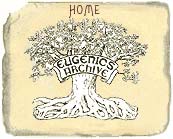
Eugenic Laws Against Race Mixing
Paul Lombardo, University of Virginia
Laws forbidding marriage between people of different races were common in America from the Colonial period through the middle of the 20th century. By 1915, twenty-eight states made marriages between "Negroes and white persons" invalid; six states included this prohibition in their constitutions.
In the early 1900's, the eugenics movement supplied a new set of arguments to support existing restrictions on interracial marriage. These arguments incorporated a "scientific" brand of racism, emphasizing the supposed biological dangers of mixing the races – also known as miscegenation. Influential writers like Madison Grant, a leading eugenicist, warned that racial mixing was "a social and racial crime." He said that acceptance of racial intermarriage would lead America toward "racial suicide" and the eventual disappearance of white civilization.
According to Grant, the mixture of "higher racial types," such as Nordic whites, with other "lower" races would inevitably result in the decline of the higher race. In his immensely popular book The Passing of the Great Race (1916) Grant cautioned: "The cross between a white man and an Indian is an Indian; the cross between a white man and a negro is a negro… When it becomes thoroughly understood that the children of mixed marriages between contrasted races belong to the lower type, the importance of transmitting in unimpaired purity the blood inheritance of ages will be appreciated at its full value."
Grant's proclamations on the perils of race mixing mirrored warnings by Charles Davenport and Harry Laughlin, leaders of the American eugenic bureaucracy at the Eugenics Record Office. In turn, American political leaders like Vice President Calvin Coolidge repeated similar sentiments as scientific fact. Said Coolidge: "Biological laws tell us that certain divergent people will not mix or blend."
To prevent further pollution of the country's collective "germ-plasm" and a subsequent contamination of the white race, eugenicists argued for even tighter restrictions against racial mixing. Their efforts focused on new legal definitions of who could qualify to receive a marriage license as a "white" person.
Virginia's Racial Integrity Act of 1924 stands out among anti-miscegenation laws that can be traced to eugenic advocacy. To fashion a successful legislative strategy, three local Virginia eugenicists – John Powell, Earnest Cox and Walter Plecker – consulted with Madison Grant and Harry Laughlin. Powell, a celebrated pianist and composer, was the founder of the Anglo-Saxon Clubs of America, an elitist version of the Ku Klux Klan dedicated to maintaining "Anglo-Saxon ideals and civilization in America." Like The Passing of the Great Race, Cox's book White America emphasized white supremacy and the dangers of racial mixing. Plecker was registrar at the Bureau of Vital Statistics of the Virginia Board of Health. His ideas on racial interbreeding as the source of "public health" problems appeared in state-published pamphlets distributed to all who planned to marry.
When The Racial Integrity Act became law, it included provisions requiring racial registration certificates and strict definitions of who would qualify as members of the white race. It emphasized the "scientific" basis of race assessment, and the "dysgenic" dangers of race mixing. Its major provision declared: "It shall hereafter be unlawful for any white person in this State to marry any save a white person, or a person with no other admixture of blood than white and American Indian. …the term "white person" shall apply only to such person as has no trace whatever of any blood other than Caucasian; but persons who have one-sixteenth or less of the blood of the American Indian and have no other non-Caucasic blood shall be deemed to be white persons…."
It is interesting to note that at least 16 members of the Virginia General Assembly who claimed to be descendants of Pocahontas objected to the first draft of the law they proposed, because it defined as "non-white" anyone with 1/64 of American Indian ancestry. Alabama and Georgia eventually copied the Virginia law. Within a decade, similar laws prohibiting inter-ethnic marriages and attempting to sort citizens by percentage of Jewish "blood" were adopted by the government of Nazi Germany.
The 1958 case of Loving v. Commonwealth of Virginia initiated a challenge that would eventually overturn the law. That year, Mildred Jeter (a black woman) and Richard Loving (a white man) were married in the District of Columbia. After moving to Virginia, they were indicted for violating the Racial Integrity Act. They pleaded guilty and were sentenced to one year in jail. The trial judge suspended their sentences on the condition that they accept banishment from the state and not return together for 25 years. The judge's written opinion declared: Almighty God created the races white, black, yellow, malay and red, and he placed them on separate continents. And but for the interference with this arrangement there would be no cause for such marriages. The fact that he separated the races shows that he did not intend for the races to mix.
The Virginia Supreme Court upheld the judge's decision, and the Lovings moved back to Washington, D.C. In 1963, another attempt to overturn their convictions in Virginia was unsuccessful. The Lovings finally appealed to the United States Supreme Court. By unanimous decision, in 1967 the Court struck down the Racial Integrity Act and similar laws of fifteen other states, saying: "[T]here can be no doubt that restricting the freedom to marry solely because of racial classifications violates the central meaning of the Equal Protection Clause … Under our Constitution, the freedom to marry, or not marry, a person of another race resides with the individual and cannot be infringed by the state."
